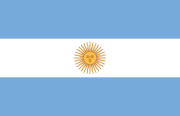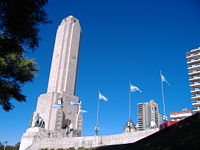Flag of Argentina
 |
|
| Use | National flag and ensign. |
| Proportion | 9:14 |
| Adopted | February 27, 1812 |
| Design | A triband flag with horizontal bands coloured light blue, white and light blue with the yellow Sun of May charged in the center |
| Designed by | Manuel Belgrano |


The national flag of Argentina dates from 1812. It is a triband, composed of three equally wide horizontal bands coloured light blue, white and light blue. In 1818, a yellow Sun of May was added to the center.
The full flag featuring the sun is called the Official Ceremonial Flag (Spanish: Bandera Official de Ceremonia). The flag without the sun is considered the Ornamental Flag (Bandera de Ornato). While both versions are equally considered the national flag, the ornamental version must always be hoisted below the Official Ceremony Flag. In vexillological terms, the Official Ceremony Flag is the civil, state and war flag and ensign, while the Ornamental Flag is an alternate civil flag and ensign.
Contents |
Official description
Shape and size
From 1978, the flag's official proportions are 9:14, and its official size is 0.9 by 1.4 metres. It features three stripes alternating cerulean blue - white. Each stripe is 30 centimetres in height. In the center stripe there is an emblem known as the Sun of May (Spanish: Sol de Mayo), a golden sun. The Sun is modeled after the symbol of Inti, the Incan god of the Sun. Flags with proportions of 1:2 and 2:3 are also in use.
Colors
The colors are officially defined using the CIE 1976 standard:
| Scheme | Sky blue | Yellow | Brown |
|---|---|---|---|
| CIE (L*, a*, b*) | 67.27, -6.88, -32.23 | 74.97, 29.22, 81.58 | 44.53, 27.16, 22.48 |
| *Black and white are as normal. *Source: http://www.manuelbelgrano.gov.ar/bandera_colores.htm | |||
The following are given for computer, textile, print and plastic use:
| Scheme | Sky blue | Yellow | Brown |
|---|---|---|---|
| RGB | 117, 170, 219 | 252, 191, 73 | 132, 53, 17 |
| Pantone (textile) | 16-4132 TC | 14-1064 TC | 18-1441 TC |
| Pantone (print) | 284 C / 284 U | 1235 C / 116 U | 284 C / 284 U |
| Pantone (plastic) | Q 300-4-1 | Q 030-2-1 | Q 120-2-4 |
| *Source: ibid. | |||
The Spanish word celeste (cerulean blue) is used to describe the colour of the blue stripes.
Sun of May
The sun, called the Sun of May, is a replica of an engraving on the first Argentine coin, approved in 1813, whose value was eight escudos (one Spanish dollar). It has 16 straight and 16 waved sunbeams.
In 1978 the sun color was specified to be golden yellow (amarillo oro), to have an inner diameter of 10 cm, and an outer diameter of 25 cm (the diameter of the sun equals  the height of the white stripe. The sun's face is
the height of the white stripe. The sun's face is  of its height). It features 32 rays, 16 undulated and 16 straight, in alternation and from 1978 it must be embroidered in the "Official Flag Ceremony".
of its height). It features 32 rays, 16 undulated and 16 straight, in alternation and from 1978 it must be embroidered in the "Official Flag Ceremony".
History
Creation

According to tradition, during the Argentine War of Independence General Manuel Belgrano was commanding a battle near Rosario. He noticed that both the Crown's forces and the independence forces were using the same colors (Spain's yellow and red). After realizing this, Belgrano created a new flag using the colors that were used by the Criollos during the May Revolution in 1810. However, recent research and studies would indicate that the colors were chosen from the coat of arms of the House of Bourbon the royal family of Spain, and that during the May Revolution the color used by the criollos was a red piece of cloth, as pointed by the popular historian Felipe Pigna. Also, apparently the original flag was quite different from the current one: it had two vertical stripes, one blue and the other one white. The flag was first flown, for the soldiers to swear allegiance to it, on 27 February 1812, on the Batería Libertad (Liberty Battery), by the Paraná River. On that day, Belgrano said the following words
|
|
Belgrano dispatched a letter addressed to the First Junta, informing them of the newly created flag. The Junta, fearing the Spanish Crown, sent a warning to Belgrano not to fight under the flag, but by the time the reply had arrived, Belgrano had moved on, and was flying the flag on the battlefield. The letter contained the following passage:
|
|
The flag was hoist for the first time in Buenos Aires atop the Saint Nicholas of Bari Church on August 23, 1812 (where nowadays the Obelisco is located).
After the declaration of independence on July 9, 1816, the flag was adopted as a symbol by the Argentine National Congress.
Changes

On February 25, 1818, a sun was added to the battle flag. The sun was copied after the one that the first Argentine coin featured in 1813. It was subsequently decided to be part of the regular flag afterwards, and thus the sun no longer represents war.
On June 8, 1938, president Roberto Ortiz sanctioned a law declaring June 20 "Flag Day", a national holiday (the date was decided after the anniversary of Belgrano's death). In 1957 the National Flag Memorial (a 10,000 m² monumental complex) was inaugurated in Rosario to commemorate the creation of the flag, and the official Flag Day ceremonies have been customarily conducted in its vicinity since then.
In 1978 it was specified, among other measurements, that the Official Ceremony Flag should be 1.4 meters in width and 0.9 meters in height, and that the sun must be embroidered.
Influence of the Argentine Flag on the flags of other countries

The Argentine commander Louis-Michel Aury (also spelled Luis Aury) used the Argentine flag as a model for the blue-white-blue flag of the first independent state in central America, which was created 1818 in Isla de Providencia, an island off the east coast of Nicaragua. This state existed until approximately 1821, before Colombia took over control of these islands. Somewhat later (1823) this flag was again the model for the flag of the United Provinces of Central America, a confederation of the current Central American states of Guatemala, Honduras, El Salvador, Nicaragua and Costa Rica, which existed from 1823 to 1838. After the dissolution of the Union, the five countries became independent, but even today all of these states except Costa Rica use flags of blue-white-blue stripes. The Argentine flag also inspired the flags of Uruguay and Paraguay.
Anthems to the flag
Aurora (Sunrise)
-
Alta en el cielo, un águila guerrera Audaz se eleva en vuelo triunfal. Azul un ala del color del cielo, Azul un ala del color del mar. Así en el alta aurora irradial. Punta de flecha el áureo rostro imita. Y forma estela el purpurado cuello. El ala es paño, el águila es bandera. Es la bandera de la patria mía, del sol nacida que me ha dado Dios. Es la bandera de la Patria Mía, del sol nacida que me ha dado Dios.
High in the sky, a warrior eagle audacious it rises in its triumphal flight A blue wing of the color of the sky A blue wing of the color of the sea Thus in the high radiant aurora. The tip of an arrow the golden face imitates. And the purple neck leaves a wake. The wing is cloth, the eagle is flag. It is the flag of my homeland, born from the sun that God gave me. It is the flag of my homeland, born from the sun that God gave me.
By: H. C. Quesada, L. Illica, H. Panizza. (In the English translation, the use of that on second and fourth lines of third paragraph, referes to the flag and not the sun).
Salve Argentina (Long live Argentina)
-
Salve, Argentina, bandera azul y blanca. Jirón del cielo en donde impera el Sol. Tú, la más noble, la más gloriosa y santa, el firmamento su color te dio. Yo te saludo, bandera de mi Patria, sublime enseña de libertad y honor. Jurando amarte, como así defenderte, mientras palpite mi fiel corazón.
Hail, Argentina, Blue and white flag Part of the sky Where the sun reigns You, The Most Noble The Most Glorious and Saint The sky gave you its colours I salute you Flag of my motherland Grand symbol of freedom and honour Swearing to love you as well as to defend you for as long as my faithful heart beats
By: Leopoldo Corretjer.
Mi Bandera (My Flag)
-
Aquí está la bandera idolatrada, la enseña que Belgrano nos legó, cuando triste la Patria esclavizada con valor sus vínculos rompió. Aquí está la bandera esplendorosa que al mundo con sus triunfos admiró, cuando altiva en la lucha y victoriosa la cima de los Andes escaló. Aquí está la bandera que un día en la batalla tremoló triunfal y, llena de orgullo y bizarría, a San Lorenzo se dirigió inmortal. Aquí está, como el cielo refulgente, ostentando sublime majestad, después de haber cruzado el Continente, exclamando a su paso: ¡Libertad! ¡Libertad! ¡Libertad!
Here is the idolized flag, the flag that Belgrano left to us, when the sad enslaved Homeland bravely broke its bonds. Here is the splendorous flag that surprised the world with its victory, when arrogant and victoriously during the fight climbed the top of the Andes Here is the flag that one day triumphantly rose in the middle of the battle and, full of pride and gallantry, went immortally to San Lorenzo Here it is, like the shining sky, showing sublimate majesty after having crossed the continent shouting in its way: "Freedom!" " Freedom! Freedom!"
Myths about the flag
The popular interpretation of the flag is that it represents the sky, clouds and sun. However, there are several theories stories about the colors of the flag. One says that the blue symbolizes the clothing of the Virgin Mary and the white symbolizes silver (the name "Argentina" comes from the Latin word for silver, argentum). Another story states that the colors are based on those of the House of Bourbon, and a third suggests that they are derived from the Río de la Plata (literally "River of Silver").
It is not known with certainty that Belgrano created the flag, but during the wars of independence against Spain, he was the first to use it, even though the criollo government didn't approve it.
Another popular belief is that the version with the sun is a war flag while the sunless version is not, but while this was originally the case after the approval of Congress in 1818, it was changed afterwards.
External links
- Argentina at Flags of the World
- All anthems to the Argentine flag
- More information (Spanish)
- Virtual Visit to the Flag Memorial
|
|||||
|
||||||||||||||
|
||||||||